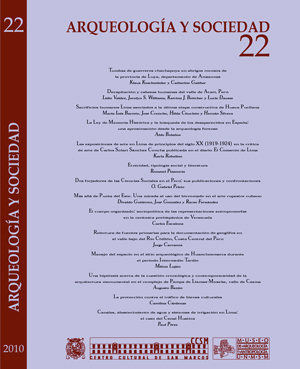GRAVES OF CHACHAPOYA WARRIORS IN ABRIGOS ROCOSOS DE LA PROVINCE OF LUYA, DEPARTMENT OF AMAZONAS
DOI:
https://doi.org/10.15381/arqueolsoc.2010n22.e12286Keywords:
Chachapoya, chiefdoms, trophy heads, rock shelters, cave paintings, trepanation.Abstract
Spanish chroniclers described the Chachapoya as a confederation of several subgroups, organized into chiefdoms of varying size and complexity. They shared many features in their architecture and material culture, but slight differences in the iconography and funerary practices at the interregional level could be reminiscent of the origins and traditions of the different subgroups, which migrated over a thousand years ago to the almost uninhabited area east of the Rio Marañon. The oral tradition transmitted to the Spanish informs us of the dual organization of Chachapoya chiefdoms: The power was divided between two chiefs, one with political power and representative of the cult, and the other closely linked with military affairs. The Chachapoya were known as brave warriors who practiced trophy head-hunting. During archaeological research in rock shelters in the province of Luya (2007) several graves of presumed Chachapoya warriors were located associated with cave paintings, which depict these warriors with their weapons and the practice of trophy head-hunting. The men were buried with varied grave goods and demonstrate fractures in various parts of the body, but especially in the skull (including trepanations). The cave paintings and the presence of “late” objects indicate that the hunting of trophy heads continued until the early colonial period.Downloads
Published
Issue
Section
License
Copyright (c) 2010 Klaus Koschmiederi, Catherine Gaither

This work is licensed under a Creative Commons Attribution-NonCommercial-ShareAlike 4.0 International License.
THE AUTHORS RETAIN THEIR RIGHTS:
a. The authors retain their trademark and patent rights, and also on any process or procedure described in the article.
b. The authors retain the right to share, copy, distribute, perform and publicly communicate the article published in the Arqueología y Sociedad (for example, place it in an institutional repository or publish it in a book), with an acknowledgment of its initial publication in the Arqueología y Sociedad.
c. The authors retain the right to make a subsequent publication of their work, to use the article or any part of it (for example: a compilation of their works, notes for conferences, thesis, or for a book), provided that they indicate the source. of publication (authors of the work, journal, volume, number and date).






